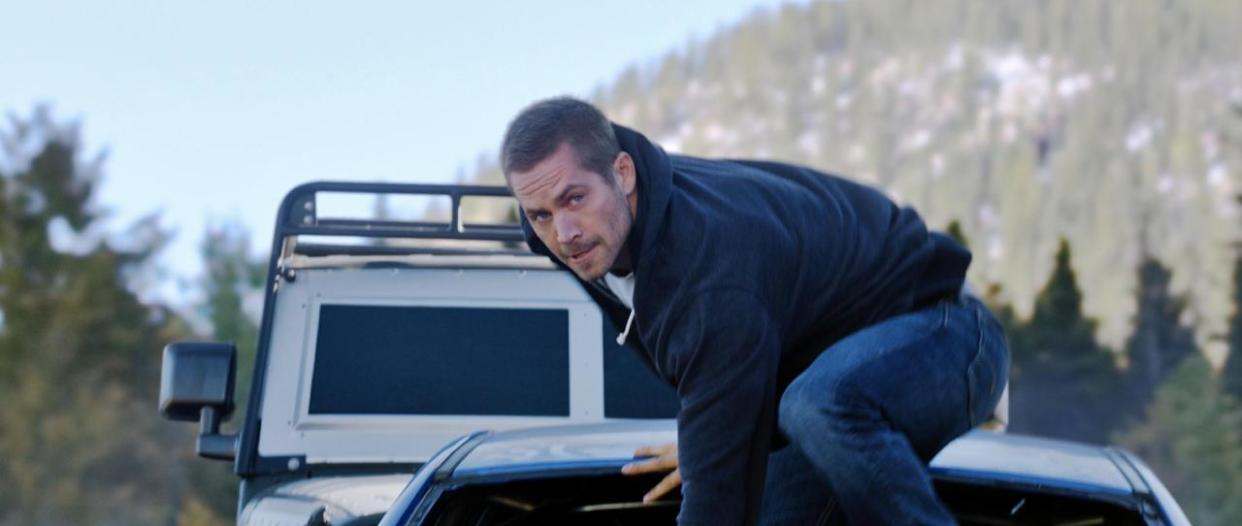'Furious 7' Visual-Effects Team Reveals Details About Creating Digital Doubles for Paul Walker

Paul Walker in ‘Furious 7′ (Universal)
Just before Universal debuted Furious 7 in April, Vin Diesel deadpanned to Variety that it would win the best picture Oscar. That’s not likely, but the film definitely merits serious awards consideration in all artisan categories: Editing, sound, cinematography, music — and visual effects.
When the film opened, the media carried brief descriptions of how the VFX team had successfully re-created some images of Paul Walker, who had died in November 2013 before the film was finished. But those anecdotes were just the tip of the iceberg; the most difficult scenes were not the spectacular stunt sequences, but the subtler closeups of Walker, which required effects that had never been done before.
Joe Letteri, Weta Digital senior VFX supervisor, says, “We had to complete a performance — what Paul Walker would have done if he’d been able to continue. And it had to be his performance.” Letteri said there was no way to do this without closeups because “anything else would have shortchanged his performance and the film.”
Related: Producer Calls ‘Furious 7’ Most Challenging Film of His Career
The Wellington, N.Z.-based Weta Digital had entered the picture because producer Neal Moritz and director James Wan wanted Furious 7 to remain faithful to the film they had started, and to include as much of Walker as possible in scenes that hadn’t been filmed. Weta ended up doing a whopping 350 shots, most of them involving Walker’s character.
Last spring, Universal and the filmmakers avoided questions about post-production challenges, for fear of appearing disrespectful of Walker’s memory. But when they spoke this week with Variety, it became clear that respect was always the top priority.
Unlike the motion-capture work that Weta had done on earlier films, there were no scans of Walker to create a digital double. So the team went through old footage, building a reference library of Walker as Brian O’Conner by using outtakes from Furious 7 and previous films in the franchise. But those moments had been filmed in one lighting environment and the Weta team “essentially had to relight his performance” digitally for each new scene, said Letteri.
Weta visual effects supervisor Martin Hill says the bus sequence got a lot of media attention, but it “paled in comparison to scenes such as Paul sitting still, or delivering dialog in closeup, because you don’t have the action and the kinetic cutting to help distract from the effects.”
For example, Walker is digital and full frame in a sequence of driving in the desert. Hill said, “Paul is trying to get to Los Angeles quickly, and is also reacting in a subtle way to the injured Kurt Russell in the backseat. The performance was very nuanced.”
The filmmakers scanned Walker’s brothers Cody and Caleb, as well as actor John Brotherton (who has a role in the film and whose build and coloring are similar to Walker’s). The three men tried to capture the timing and direction that director Wan wanted. Weta essentially motion-captured the work of the three men, and then reapplied that to Walker digital models they had created.
Those digital models included extensive work on Walker’s hair and skin — how his facial muscles moved if he frowned or raised his eyebrows, how his coloring would flush after exertion or how thehair changes depending on the light or the wind. They even worked to make sure he blinked in character.
Hill says the first goal was to create a photo-real digital human who can believably move and act onscreen. “That’s a high bar in itself, to create that. Beyond that, this actor was known to millions of fans, and this had to be Paul Walker — more specifically, Walker in character as Brian O’Conner.”
For a scene in Los Angeles, the principal characters all stand in a line, and Walker’s character “is giving meaningful looks to the others and delivering dialog, and he’s full frame. That visual effects work had to be invisible,” says Hill. They could have digitally placed Walker’s face on another person’s body, but the artists said audiences would have sensed the difference.
Particularly important was a sequence in the original script, after Brian has had a near-death experience and is trying to decide between his life as a family man or a life of adventure. Director Wan told the team, “This is the key moment in the arc of Brian’s character” so it was important to get it right digitally. He asked “Can we get that kind of nuanced performance?” The moment becomes particularly poignant, because Brian/Walker is exiting the team.
In the end, everyone was pleased with the results. Technology is changing so quickly, could this have been accomplished five years ago?
Letteri exhales briefly and says, “No. It was barely possible last year when we did it.”
The film had always been an ambitious project, with several VFX companies (including Digital Domain and Scanline) working on other scenes; there was a lot of strategizing and overtime work from a Furious team that included VFX supervisor Michael J. Wassel, co-vfx supervisor Kelvin McIlwain, SPFX coordinator Dan Sudick and others. All the post-production work was intense, with every artisan working under time pressure, as well as emotional pressure.
Hill said it was sad to work on these scenes, but the results were “the high point of my career.” He saluted the Weta team and all the other artisans who worked on the film, saying, “We knew we were doing something special for the filmmakers, the fans, the family — and for Paul’s legacy. We wanted to give him the sendoff that he deserved.”
Watch the ‘Furious 7′ cast talk about coming back to work after Walker’s death:

